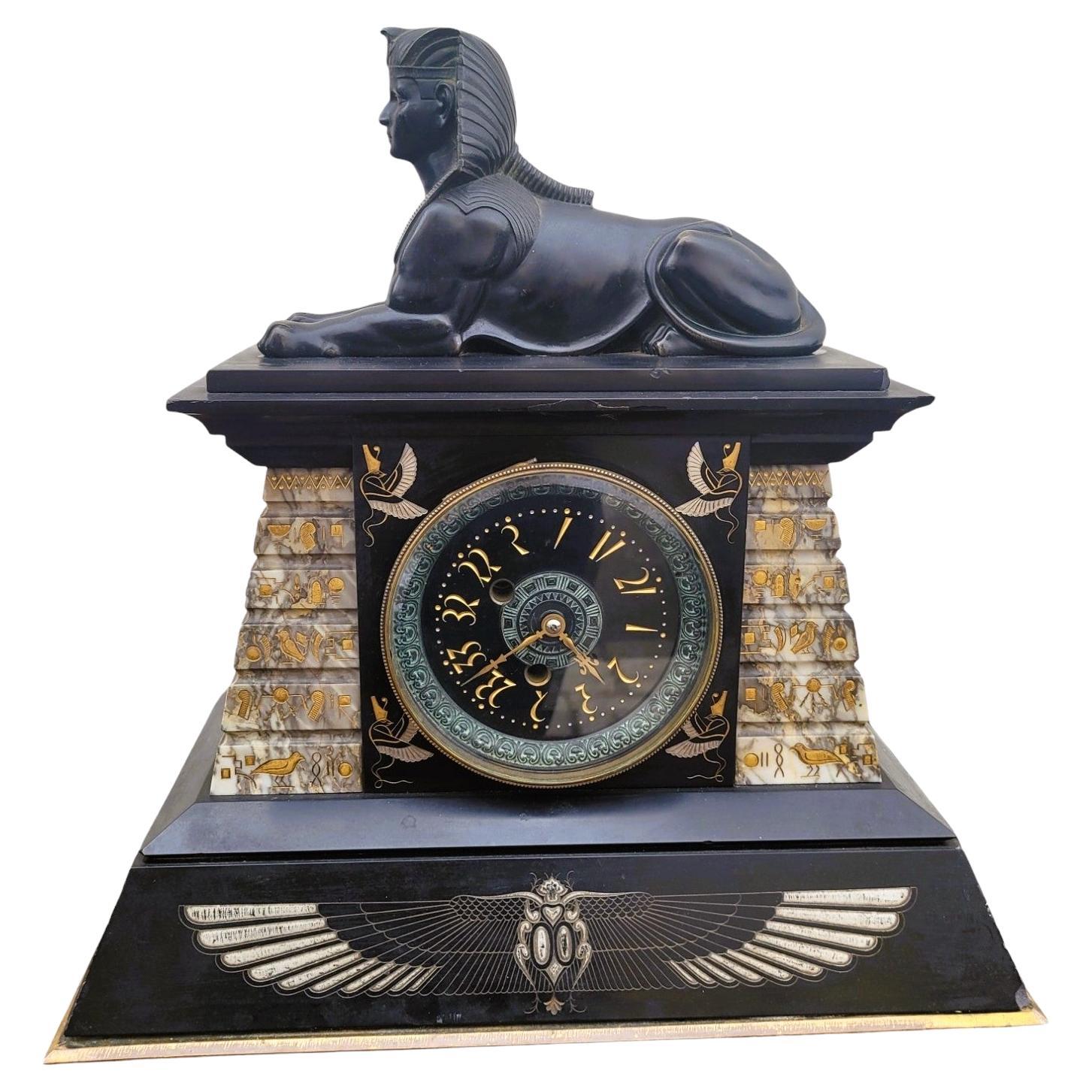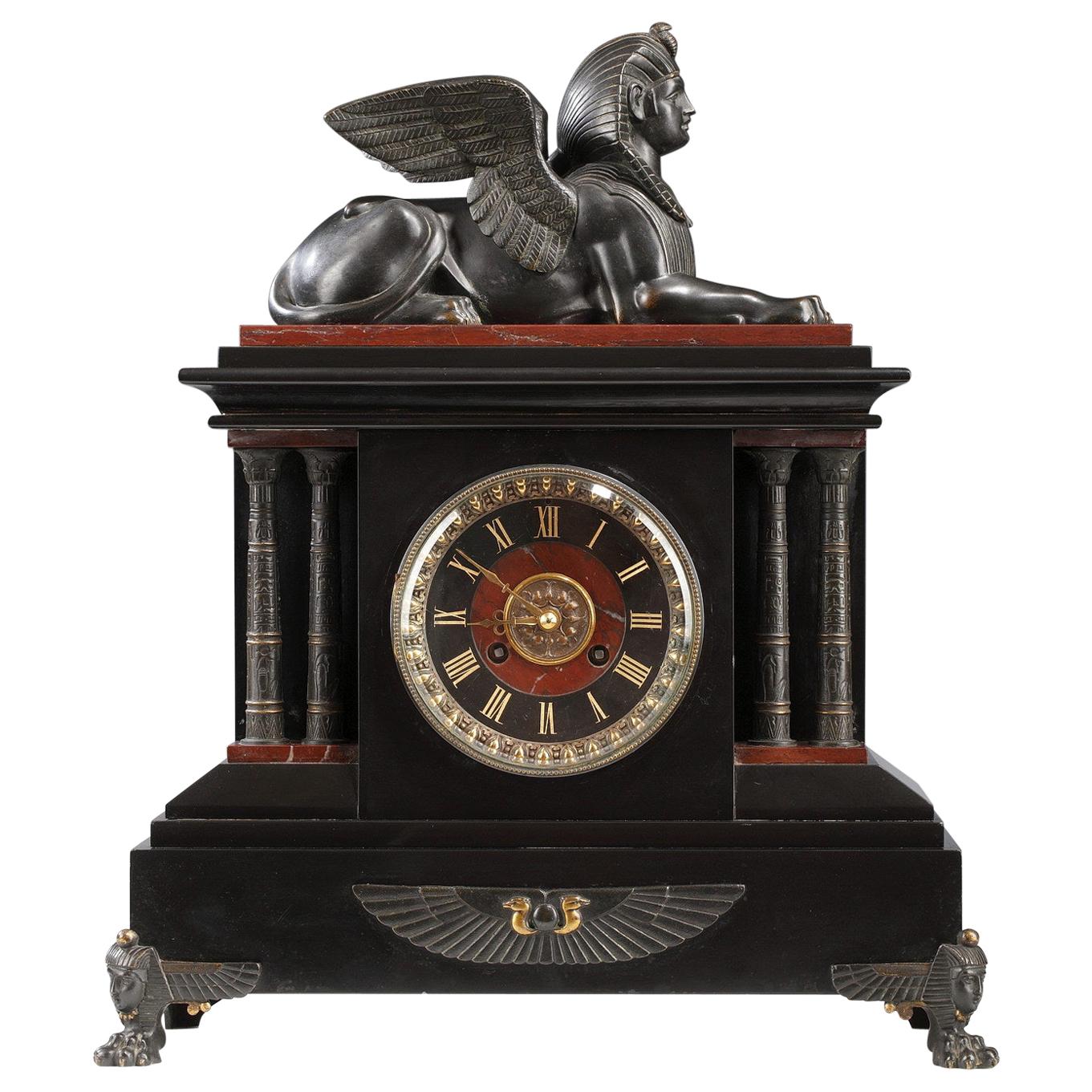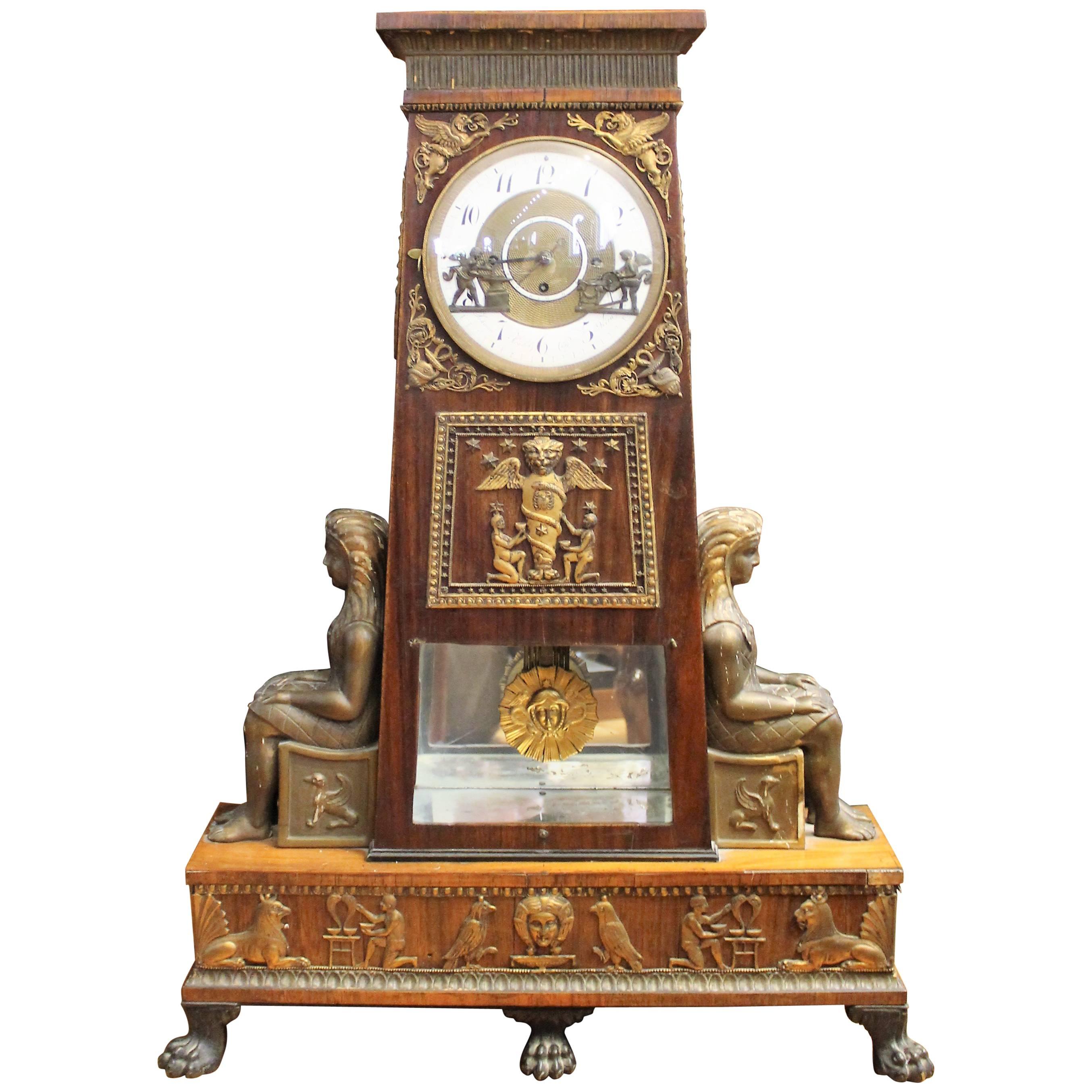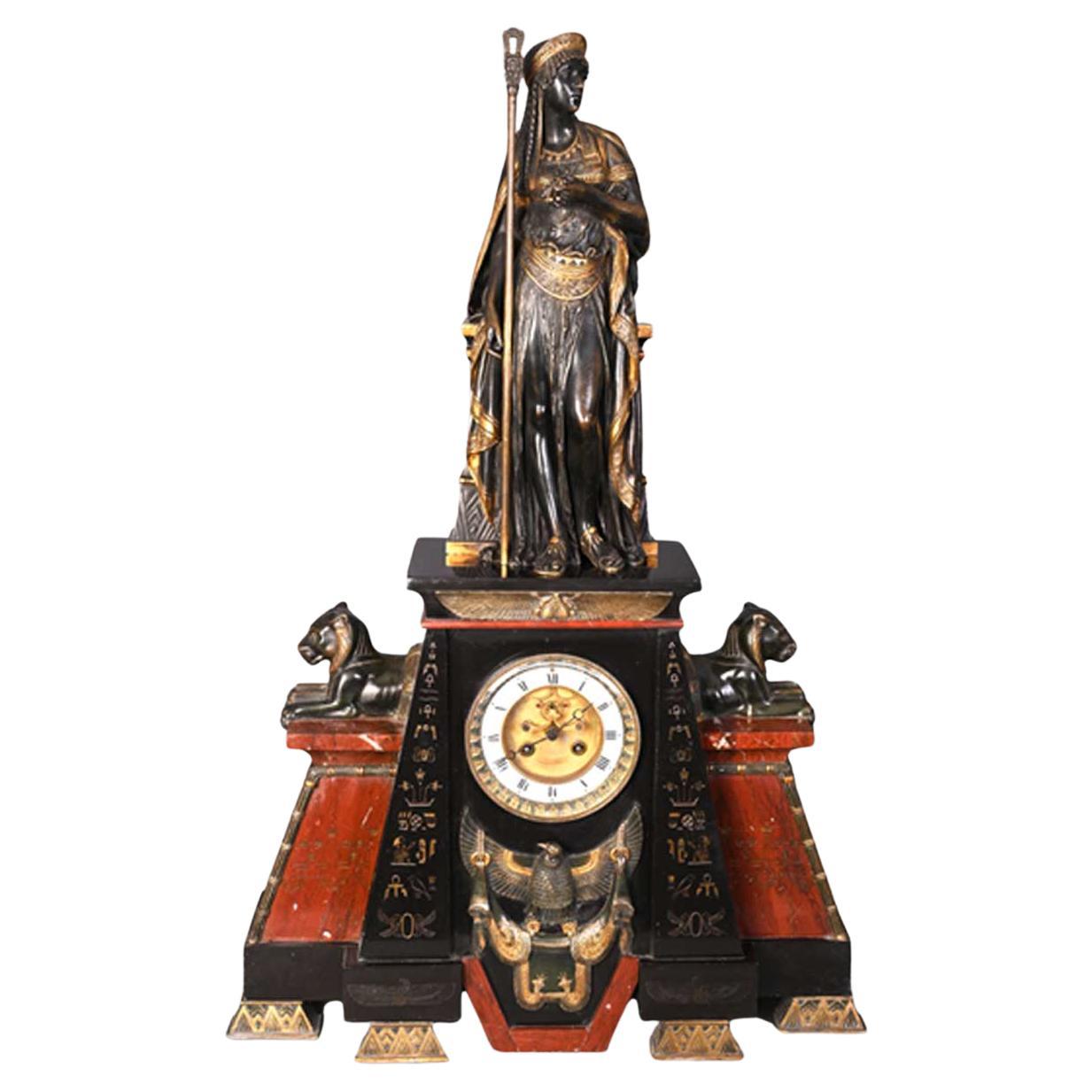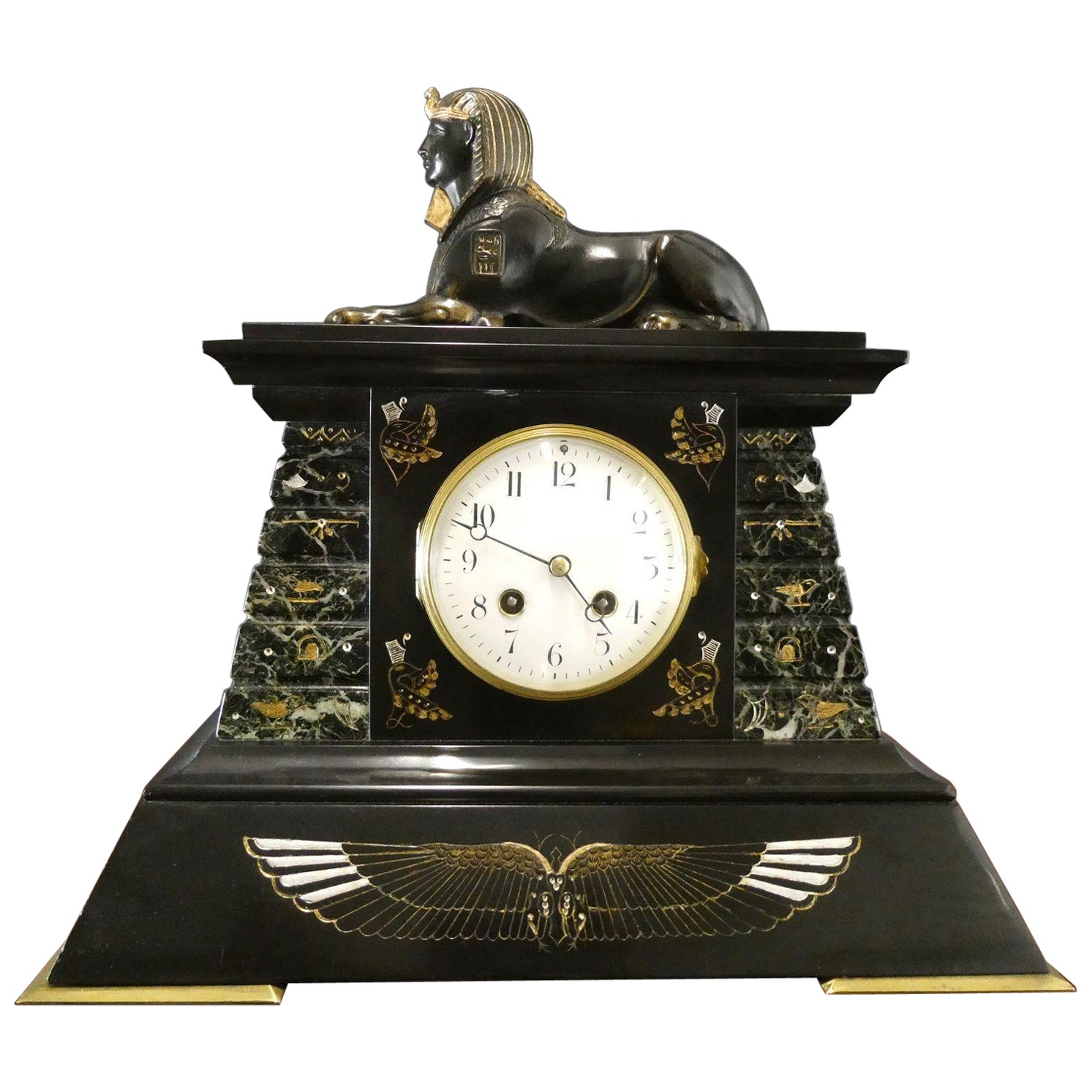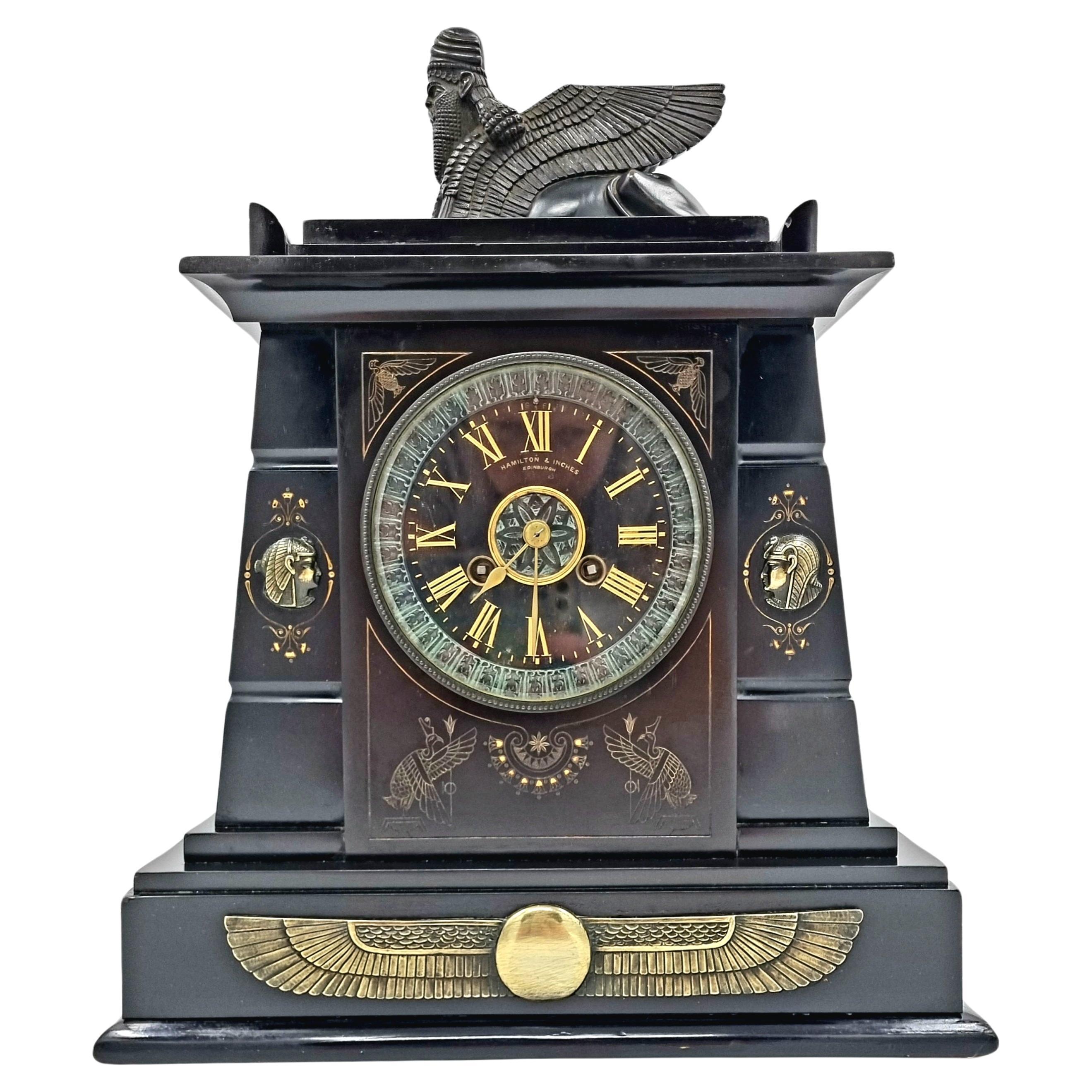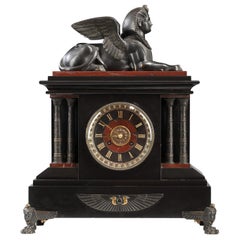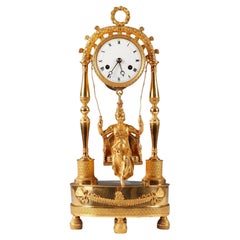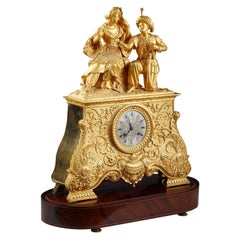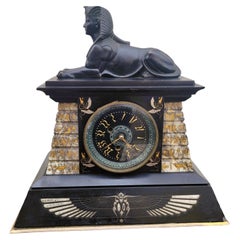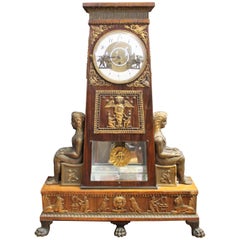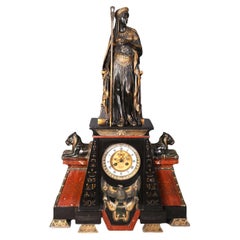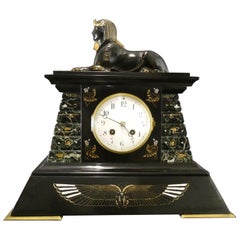Items Similar to Neo-Egyptian Marble Clock Attributed to G. Servant, France, Circa 1870
Want more images or videos?
Request additional images or videos from the seller
1 of 7
Neo-Egyptian Marble Clock Attributed to G. Servant, France, Circa 1870
$16,127.84
£11,761.16
€13,500
CA$22,062.57
A$24,688.63
CHF 12,891.24
MX$303,521.01
NOK 162,637.89
SEK 153,041.45
DKK 102,734.76
Shipping
Retrieving quote...The 1stDibs Promise:
Authenticity Guarantee,
Money-Back Guarantee,
24-Hour Cancellation
About the Item
Black and red marble pyramid shaped Egyptian style clock attributed to G. Servant, surmounted by a patinated bronze figure representing the Egyptian goddess Isis sitting on her throne. Wearing the Hathor hairdress (the solar disc surrounded by the sacred cow horns), she holds in her right hand the Ouadj, the goddesses scepter surmounted by a canopy of papyrus, symbolizing health and eternal youth and in her left hand, the cross of life Ankh, symbol of rebirth and eternity.
That Egyptian style in fashion since Napoleon the First and his military campaigns in Egypt around 1799 was rediscovered in France in the 1830's and above all in the 1860's. Some renowned French artists, such the sculptors and bronze-casters Guillaume Denière (1815-1903), Emile Hébert (1828-1893) et Georges Servant (1828-1890), presented at the 1867 and 1878 Paris Universal Exhibitions, an a-part section dedicated to their Egyptian style production. Their shows drew then considerable attention from the public and the wealthy collectors. During the 1867 Universal Exhibition, one could admire the Stand realized by the French silversmith-jeweller Gustave Baugrand (1826-1870), where his works executed in most Fine materials took inspiration from the Egyptian Antiques, exhibited then in the Louvre museum.
Georges Emile Henri Servant (1828-c.1890), who took over his father in 1855 at their foundry, rue Vieille-du-Temple, in Paris, specialized in the production of neo-Egyptian style clocks, very popular in France since 1860’s, and also the making of Greek style decorative objects. He drew considerable attention to the high quality of his bronzes at the 1855 Paris Universal Exhibition and then at the 1862 London Exhibition. At this time Servant exported up to 40% of his production, principally to the United States, where for instance, his clocks were sold with great success by Louis Tiffany Inc. or Hamann & Roche of New York. But his success came really at the 1867 Paris Universal Exhibition, where he was awarded a gold medal for his neo-Greek and Egyptian works (Les Merveilles de l’Exposition Universelle de 1867, t. II, p° 165 & 167). He was even awarded in 1874 the « Ordre national de la Légion d’Honneur », France’s highest official mark of recognition. Servant participated once again successfully at the 1878 Paris Universal Exhibition, where he not only exhibited vases and small bronze pieces of furniture, but was also a member of the jury for the class of bronze pieces of art. He finally retired shortly before the 1889 Paris Universal Exhibition.
- Attributed to:Georges Emile Henri Servant (Maker)
- Dimensions:Height: 22.05 in (56 cm)Width: 10.63 in (27 cm)Depth: 7.09 in (18 cm)
- Style:Egyptian Revival (In the Style Of)
- Materials and Techniques:
- Place of Origin:
- Period:
- Date of Manufacture:circa 1870
- Condition:Wear consistent with age and use. Minor losses.
- Seller Location:PARIS, FR
- Reference Number:Seller: 12511stDibs: LU3860321427642
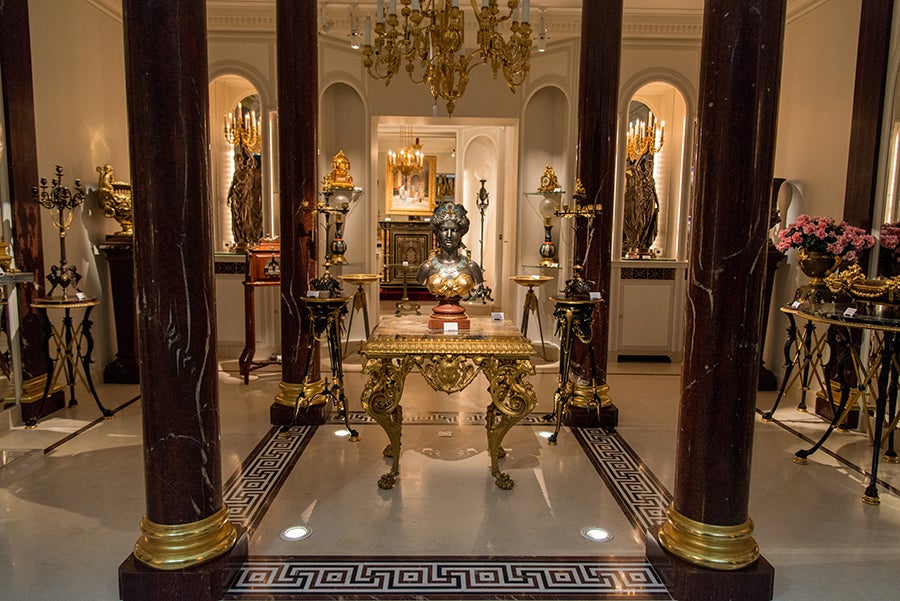
About the Seller
4.9
Gold Seller
Premium sellers maintaining a 4.3+ rating and 24-hour response times
Established in 1997
1stDibs seller since 2018
86 sales on 1stDibs
Typical response time: 2 hours
Associations
International Confederation of Art and Antique Dealers' Associations
- ShippingRetrieving quote...Shipping from: PARIS, France
- Return Policy
Authenticity Guarantee
In the unlikely event there’s an issue with an item’s authenticity, contact us within 1 year for a full refund. DetailsMoney-Back Guarantee
If your item is not as described, is damaged in transit, or does not arrive, contact us within 7 days for a full refund. Details24-Hour Cancellation
You have a 24-hour grace period in which to reconsider your purchase, with no questions asked.Vetted Professional Sellers
Our world-class sellers must adhere to strict standards for service and quality, maintaining the integrity of our listings.Price-Match Guarantee
If you find that a seller listed the same item for a lower price elsewhere, we’ll match it.Trusted Global Delivery
Our best-in-class carrier network provides specialized shipping options worldwide, including custom delivery.More From This Seller
View AllNeo-Egyptian Bronze and Marble Clock Attributed to G.Servant, France, Circa 1870
By Georges Emile Henri Servant
Located in PARIS, FR
A black and red marble clock in the shape of an Egyptian temple attributed to G. Servant, flanked by double columns inscribed with hieroglyphs and ornated with a winged uraeus, all made in two patina bronze. The clock is surmounted by a patinated bronze sphinx. Resting on four bronze faces wearing the nemes and terminating in lion paw feet.
Georges Emile Henri Servant (circa 1828-1890) who took over his father in 1855 at their foundry, rue Vieille-du-Temple, in Paris, specialized in the production of neo-Egyptian style clocks, very popular in France since 1860s, and also the making of Greek style decorative objects. He drew considerable attention to the high quality of his bronzes at the 1855 Paris Universal Exhibition and then at the 1862 London Exhibition. At this time Servant exported up to 40% of his production, principally to the United States, where for instance, his sphinx clocks were sold with great success by Louis Tiffany Inc. or Hamann & Roche of New York (A similar clock is now exposed at the Metropolitan Museum of Art, New York). But his success came really at the 1867 Paris Universal Exhibition, where he was awarded a gold medal for his neo-Greek and Egyptian works (Les Merveilles...
Category
Antique 1870s French Egyptian Revival Mantel Clocks
Materials
Marble, Bronze
Ormolu Clock "with a Swing", France, circa 1820
Located in PARIS, FR
Very fine floral and decorated Restauration period ormolu clock, figuring two baluster columns joint together by a floral arch, and topped by a crown of roses. Roman numbers indicate...
Category
Antique 1820s French Restauration Mantel Clocks
Materials
Bronze
Fine Neo-Greek Clock Set by H. Houdebine, France, Circa 1867
By Henri Houdebine
Located in PARIS, FR
Dial signed H. Houdebine, Fabricant de Bronzes, Rue de Turenne 64, Paris
and clockwork signed Japy Frères & Cie – Médaille d’Honneur
A very fine neo-Greek style clock set made up of...
Category
Antique 1860s French Greek Revival Table Clocks and Desk Clocks
Materials
Bronze
$10,512 Sale Price / set
29% Off
Leila and the Giaour Gilded Bronze Clock, France, Circa 1830
Located in PARIS, FR
Dial signed Polti Frères
Measures: With base or glass: Height 61 cm (24 in.), width 51,5 cm (20.3 in.), depth 23.5 cm (9,2 in.)
Without base: Height 52 cm (20,5 in.), width 42 cm (16.5 in.), depth 12.5 cm (4.9 in.)
Important philhellenic clock in burnished and amati gilded bronze, finely chiseled, representing on the terrace a couple elegantly dressed in "the turkish style", and richly decorated with foliage, scrolls and flowers. The feet, decorated with water leaves, rest on an oval wooden base covered with a globe.
The theme of the clock comes from The Giaour, a fragment of a Turkish Tale, an English poem by Lord Byron published in may 1813 which tells the thwarted love of a Venetian, the Giaour – term by which the Turks designate infidels and especially Christians – and of Leila, a slave belonging to Hassan’s seraglio, military leader of a Turkish province. The betrayal of Leila discovered, she will be thrown into the sea and her lover will avenge her by killing Hassan, then taking refuge in a monastery.
Symbol of prestige and modernity, the decorative clocks are a reflection of the taste of the era of a wealthy bourgeoisie and may be the subject of diplomatic gifts or between individuals.
Beyond the purely decorative aspect of such objects, watchmaking in the 19th century is part of a subtle mix of political, historical and literary references.
This philhellenic movement converning the West finds a particular echo in France, one of the countries with the United Kingdom and Russia having suported the Greeks during their war of independance (1821-1830) to free oneself from the grip of the Ottoman Empire. Many clocks...
Category
Antique 1830s French Mantel Clocks
Materials
Bronze
$12,902 Sale Price
55% Off
A-E Beurdeley, « The Coronation of Science » Clock, France, circa 1880
By Emmanuel-Alfred Beurdeley
Located in PARIS, FR
Signed on the dial A. Beurdeley Paris
Mechanism signed J LEFEBVRE FILS PARIS
Rare Louis XVI style clock in mercury-gilded and patinated chiseled bronze and white marble. In the form...
Category
Antique 1870s French Louis XVI Mantel Clocks
Materials
Marble, Bronze
"The Source" Gilt bronze Clock attr. to L. Messagé & F.Linke, France, circa 1890
By François Linke
Located in PARIS, FR
Charming clock in the shape of a Rocaille-inspired cartel in chiseled and gilded bronze. Scalloped marine-inspired decor representing a trophy with oars, dolphins, reeds and flowers ...
Category
Antique 1890s French Rococo Revival Table Clocks and Desk Clocks
Materials
Bronze, Enamel
You May Also Like
Egyptomania Marble Clock, 19th Century
Located in MARSEILLE, FR
Large clock in the style of Egyptomania, in marble of different colors, decorated with stylized hieroglyphs, falcons and scarabs.
It is topped with a sphinx in patinated bronze.
Eg...
Category
Antique 19th Century French Egyptian Revival Mantel Clocks
Materials
Marble
Egyptian Revival Grande Sonnerie Clock from the Biedermeier Period
Located in Hamilton, Ontario
Egyptian Revival Grande Sonnerie clock from the Biedermeier period. It features animated workmen that swing an anvil, pump bellows while making a 'clac...
Category
Antique 19th Century Egyptian Revival Mantel Clocks
Egyptian Revival Mantel Clock, 19th Century
By Georges Emile Henri Servant
Located in SAINT-OUEN-SUR-SEINE, FR
Mantel clock in patinated and gilt bronze, with red and black marble, in the Egyptian Revival style of the 19th century.
The composition features a standing female Egyptian figure h...
Category
Antique 19th Century French Egyptian Revival Mantel Clocks
Materials
Marble, Bronze
Egyptian Revival Bronze and Marble Mantel Clock
By Societe Clusienne
Located in Norwich, GB
Egyptian Revival Bronze and Marble Mantel Clock
Egyptian revival mantel clock housed in a polishes black slate and marble stepped case, decorated with winged uraeus and hieroglyphs, surmounted by a patinated bronze sphinx wearing nemes and resting on lions paw feet.
Enamel dial with Arabic numerals and original ‘blued’ steel hands.
Eight day French movement with anchor escapement striking the hours and halves on a silvered bell. The backplate signed Societe Clusienne S.C.A.P.H. Cluses and numbered 4144. C.1870
Societe Clusienne were based in Cluses near to the Swiss border in France.
The case attributed to G.Servant
Georges Emile Henri Servant ( 1828-1890) succeeded his father at their foundry at Rue Vieille-du-Temple, Paris in 1855. He specialised in the production of Neo-Egyptian style clocks.
He was noted for the high quality of his bronzes at both the Paris Universal Exhibition 1855 and the London Exhibition in 1862.
Many of his clocks were exported to the United States where his Sphinx clocks...
Category
Antique 1870s French Mantel Clocks
Materials
Slate
19th Century Egyptian Revival Clock by Hamilton and Inches
Located in Hoddesdon, GB
An Egyptian Revival Black Marble Clock
Circa 1860s made by the renowned clock and jewellery makers Hamilton and Inches of Edinburgh with Royal ...
Category
Antique Mid-19th Century Scottish Egyptian Revival Mantel Clocks
Materials
Bronze
A Gilded Egyptian Revival Timepiece Desk Clock
Located in Amersham, GB
An Egyptian revival timepiece in a gilded and bronzed case. The four pillared eight day movement with a cylinder escapement is housed in a drum case, mounted behind a crisp white ena...
Category
Antique Late 19th Century French Egyptian Revival Table Clocks and Desk ...
Materials
Siena Marble, Brass, Bronze
